Dynamics of Cropland Non-Agriculturalization in Shaanxi Province of China and Its Attribution Using a Machine Learning Approach
Abstract
1. Introduction
2. Materials and Methods
2.1. Study Area
2.2. Data Source and Processing
2.3. Spatial Analysis Method of CLNA
2.3.1. Moran’s I
2.3.2. Geo-Detector
2.3.3. Model Selection and Evaluation
3. Results
3.1. The Spatiotemporal Characteristics of CLNA in SP from 2001 to 2020
3.2. Spatial Aggregation Characteristics of CLNA in SP from 2001 to 2020
3.3. The Explanatory Power and Contribution of Different Driving Factors on CLNA
4. Discussion
4.1. Spatiotemporal Pattern of CLNA in SP
4.2. Causes of CLNA in SP from 2001–2020
5. Conclusions
Author Contributions
Funding
Data Availability Statement
Acknowledgments
Conflicts of Interest
References
- Cumming, G.S.; Buerkert, A.; Hoffmann, E.M.; Schlecht, E.; von Cramon-Taubadel, S.; Tscharntke, T. Implications of agricultural transitions and urbanization for ecosystem services. Nature 2014, 515, 50–57. [Google Scholar] [CrossRef] [PubMed]
- Viana, C.M.; Freire, D.; Abrantes, P.; Rocha, J.; Pereira, P. Agricultural land systems importance for supporting food security and sustainable development goals: A systematic review. Sci. Total Environ. 2022, 806, 150718. [Google Scholar] [CrossRef]
- Pretty, J. Intensification for redesigned and sustainable agricultural systems. Science 2018, 362, eaav0294. [Google Scholar] [CrossRef] [PubMed]
- Ghose, B. Food security and food self-sufficiency in China: From past to 2050. Food Energy Secur. 2014, 3, 86–95. [Google Scholar] [CrossRef]
- Wei, Y.D.; Ye, X. Urbanization, urban land expansion and environmental change in China. Stoch. Environ. Res. Risk Assess. 2014, 28, 757–765. [Google Scholar] [CrossRef]
- Chien, S.-S. Local farmland loss and preservation in China A perspective of quota territorialization. Land Use Policy 2015, 49, 65–74. [Google Scholar] [CrossRef]
- Zhang, G.; Li, X.; Zhang, L.; Wei, X. Dynamics and causes of cropland non-agriculturalization in typical regions of China: An explanation Based on interpretable Machine learning. Ecol. Indic. 2024, 166, 112348. [Google Scholar] [CrossRef]
- Chen, B.; Yao, N. Evolution characteristics of cultivated land protection policy in China based on smith policy implementation. Agriculture 2024, 14, 1194. [Google Scholar] [CrossRef]
- Fu, B.; Li, S.; Yu, X.; Yang, P.; Yu, G.; Feng, R.; Zhuang, X. Chinese ecosystem research network: Progress and perspectives. Ecol. Complex. 2010, 7, 225–233. [Google Scholar] [CrossRef]
- Cai, T.; Zhang, X.; Xia, F.; Zhang, Z.; Yin, J.; Wu, S. The process-mode-driving force of cropland expansion in arid regions of China based on the land use remote sensing monitoring data. Remote Sens. 2021, 13, 2949. [Google Scholar] [CrossRef]
- Gu, C.; Hu, L.; Cook, I.G. China’s urbanization in 1949–2015: Processes and driving forces. Chin. Geogr. Sci. 2017, 27, 847–859. [Google Scholar] [CrossRef]
- Wang, X.; Li, X. China’s agricultural land use change and its underlying drivers: A literature review. J. Geogr. Sci. 2021, 31, 1222–1242. [Google Scholar] [CrossRef]
- Shi, K.; Yu, B.; Ma, J.; Cao, W.; Cui, Y. Impacts of slope climbing of urban expansion on global sustainable development. Innovation 2023, 4, 100529. [Google Scholar] [CrossRef] [PubMed]
- Li, D.; He, L.; Qu, J.; Xu, X. Spatial evolution of cultivated land in the Heilongjiang Province in China from 1980 to 2015. Environ. Monit. Assess. 2022, 194, 444. [Google Scholar] [CrossRef]
- Bryan, B.A.; Gao, L.; Ye, Y.; Sun, X.; Connor, J.D.; Crossman, N.D.; Stafford-Smith, M.; Wu, J.; He, C.; Yu, D.; et al. China’s response to a national land-system sustainability emergency. Nature 2018, 559, 193–204. [Google Scholar] [CrossRef]
- Chen, Y.; Wang, S.; Wang, Y. Spatiotemporal evolution of cultivated land non-agriculturalization and its drivers in typical areas of southwest China from 2000 to 2020. Remote Sens. 2022, 14, 3211. [Google Scholar] [CrossRef]
- Long, H.; Tu, S.; Ge, D.; Li, T.; Liu, Y. The allocation and management of critical resources in rural China under restructuring: Problems and prospects. J. Rural Stud. 2016, 47, 392–412. [Google Scholar] [CrossRef]
- Zhang, B.; Sun, P.; Jiang, G.; Zhang, R.; Gao, J. Rural land use transition of mountainous areas and policy implications for land consolidation in China. J. Geogr. Sci. 2019, 29, 1713–1730. [Google Scholar] [CrossRef]
- Zhao, H.L.; Zhou, R.L.; Zhang, T.H.; Zhao, X.Y. Effects of desertification on soil and crop growth properties in Horqin sandy cropland of Inner Mongolia, north China. Soil Tillage Res. 2006, 87, 175–185. [Google Scholar] [CrossRef]
- Xu, X.; Tang, Q. Spatiotemporal variations in damages to cropland from agrometeorological disasters in mainland China during 1978-2018. Sci. Total Environ. 2021, 785, 147247. [Google Scholar] [CrossRef]
- Jiang, C.; Zhang, H.; Wang, X.; Feng, Y.; Labzovskii, L. Challenging the land degradation in China’s Loess Plateau: Benefits, limitations, sustainability, and adaptive strategies of soil and water conservation. Ecol. Eng. 2019, 127, 135–150. [Google Scholar] [CrossRef]
- Zhang, L.; Lu, D.; Li, Q.; Lu, S. Impacts of socioeconomic factors on cropland transition and its adaptation in Beijing, China. Environ. Earth Sci. 2018, 77, 575. [Google Scholar] [CrossRef]
- Liu, X.H.; Wang, J.F.; Liu, M.L.; Meng, B. Spatial heterogeneity of the driving forces of cropland change in China. Sci. China Ser. D-Earth Sci. 2005, 48, 2231–2240. [Google Scholar] [CrossRef]
- Xie, Y.C.; Mei, Y.; Tian, G.J.; Xing, X.R. Socio-econornic driving forces of arable land conversion: A case study of Wuxian City, China. Glob. Environ. Chang.-Hum. Policy Dimens. 2005, 15, 238–252. [Google Scholar] [CrossRef]
- Liu, J.Y.; Liu, M.L.; Tian, H.Q.; Zhuang, D.F.; Zhang, Z.X.; Zhang, W.; Tang, X.M.; Deng, X.Z. Spatial and temporal patterns of China’s cropland during 1990–2000: An analysis based on Landsat TM data. Remote Sens. Environ. 2005, 98, 442–456. [Google Scholar] [CrossRef]
- Poddar, I.; Roy, R. Application of GIS-based data-driven bivariate statistical models for landslide prediction: A case study of highly affected landslide prone areas of Teesta River basin. Quat. Sci. Adv. 2024, 13, 100150. [Google Scholar] [CrossRef]
- Yang, M.; Gao, X.; Zhao, X.; Wu, P. Scale effect and spatially explicit drivers of interactions between ecosystem services—A case study from the Loess Plateau. Sci. Total Environ. 2021, 785, 147389. [Google Scholar] [CrossRef]
- Wang, S.; Liu, Y.; Wang, W.; Zhao, G.; Liang, H. Interpretable machine learning guided by physical mechanisms reveals drivers of runoff under dynamic land use changes. J. Environ. Manag. 2024, 367, 121978. [Google Scholar] [CrossRef] [PubMed]
- Xu, W.; Sun, T. Evaluation of rural habitat environment in under-developed areas of Western China: A case study of Northern Shaanxi. Environ. Dev. Sustain. 2022, 24, 10503–10539. [Google Scholar] [CrossRef]
- Wei, X.; Wang, S.; Yuan, X.; Wang, X.; Zhang, B. Spatial and temporal changes and its variation of cultivated land quality in Shaanxi Province. Trans. Chin. Soc. Agric. Eng. 2018, 34, 240–248. [Google Scholar]
- Chen, H.; Marter-Kenyon, J.; Lopez-Carr, D.; Liang, X.-y. Land cover and landscape changes in Shaanxi Province during China’s Grain for Green Program (2000–2010). Environ. Monit. Assess. 2015, 187, 644. [Google Scholar] [CrossRef] [PubMed]
- Zhou, D.; Zhao, S.; Zhu, C. The Grain for Green Project induced land cover change in the Loess Plateau: A case study with Ansai County, Shanxi Province, China. Ecol. Indic. 2012, 23, 88–94. [Google Scholar] [CrossRef]
- Zhang, Q.; Li, F. Correlation between land use spatial and functional transition: A case study of Shaanxi Province, China. Land Use Policy 2022, 119, 106194. [Google Scholar] [CrossRef]
- Huang, H.; Zhou, Y.; Qian, M.; Zeng, Z. Land use transition and driving forces in Chinese Loess Plateau: A case study from Pu County, Shanxi Province. Land 2021, 10, 67. [Google Scholar] [CrossRef]
- Jiang, S.; Chen, X.; Smettem, K.; Wang, T. Climate and land use influences on changing spatiotemporal patterns of mountain vegetation cover in southwest China. Ecol. Indic. 2020, 121, 107193. [Google Scholar] [CrossRef]
- Li, S.; Yan, J.; Liu, X.; Wan, J. Response of vegetation restoration to climate change and human activities in Shaanxi-Gansu-Ningxia Region. J. Geogr. Sci. 2013, 23, 98–112. [Google Scholar] [CrossRef]
- Liu, S.; Yao, S. The effect of precipitation on the Cost-Effectiveness of Sloping land conversion Program: A case study of Shaanxi Province, China. Ecol. Indic. 2021, 132, 108251. [Google Scholar] [CrossRef]
- Li, J.; Shangguan, Z. Spatial-temporal distribution of cultivated land production capacity in Shaanxi province. Trans. Chin. Soc. Agric. Eng. 2012, 28, 239–246. [Google Scholar]
- Qiu, J.-j.; Wang, L.-g.; Li, H.; Tang, H.-j.; Li, C.-s.; Van Ranst, E. Modeling the impacts of soil organic carbon content of croplands on crop yields in China. Agric. Sci. China 2009, 8, 464–471. [Google Scholar] [CrossRef]
- Tu, Y.; Wu, S.; Chen, B.; Weng, Q.; Bai, Y.; Yang, J.; Yu, L.; Xu, B. A 30 m annual cropland dataset of China from 1986 to 2021. Earth Syst. Sci. Data 2024, 16, 2297–2316. [Google Scholar] [CrossRef]
- Anselin, L. Local indicators of spatial association-LISA. Geogr. Anal. 1995, 27, 93–115. [Google Scholar] [CrossRef]
- Anselin, L. Spatial dependence in linear regression models with an introduction to spatial econometrics. Handb. Appl. Econ. Stat. 1998, 21, 74. [Google Scholar]
- Wang, J.-F.; Zhang, T.-L.; Fu, B.-J. A measure of spatial stratified heterogeneity. Ecol. Indic. 2016, 67, 250–256. [Google Scholar] [CrossRef]
- Belgiu, M.; Dragut, L. Random forest in remote sensing: A review of applications and future directions. Isprs J. Photogramm. Remote Sens. 2016, 114, 24–31. [Google Scholar] [CrossRef]
- Chen, T.; Guestrin, C. XGBoost: A scalable tree boosting system. In Proceedings of the 22nd ACM SIGKDD International Conference on Knowledge Discovery and Data Mining, San Francisco, CA, USA, 13–17 August 2016; pp. 785–794. [Google Scholar]
- Ke, G.; Meng, Q.; Finley, T.; Wang, T.; Chen, W.; Ma, W.; Ye, Q.; Liu, T.-Y. LightGBM: A highly efficient gradient boosting decision tree. In Proceedings of the 31st Annual Conference on Neural Information Processing Systems (NIPS), Long Beach, CA, USA, 4–9 December 2017. [Google Scholar]
- Irwin, E.G.; Geoghegan, J. Theory, data, methods: Developing spatially explicit economic models of land use change. Agric. Ecosyst. Environ. 2001, 85, 7–23. [Google Scholar] [CrossRef]
- Wang, H.; Yang, J.; Chen, G.; Ren, C.; Zhang, J. Machine learning applications on air temperature prediction in the urban canopy layer: A critical review of 2011–2022. Urban Clim. 2023, 49, 101499. [Google Scholar] [CrossRef]
- Han, L.; Zhao, J.; Gao, Y.; Gu, Z. Prediction and evaluation of spatial distributions of ozone and urban heat island using a machine learning modified land use regression method. Sustain. Cities Soc. 2022, 78, 103643. [Google Scholar] [CrossRef]
- Zhu, Y.; Zhang, X.; Sun, H. Regionalization of soil and water conversation in Hanzhong City, Shaanxi Province. Bull. Soil Water Conserv. 2018, 38, 149–153,160. [Google Scholar]
- Zhu, Z.L.; Chen, D.L. Nitrogen fertilizer use in China—Contributions to food production, impacts on the environment and best management strategies. Nutr. Cycl. Agroecosystems 2002, 63, 117–127. [Google Scholar] [CrossRef]
- Zhang, X.; Su, B.; Yang, J.; Cong, J. Analysis of Shanxi Province’s energy consumption and intensity using input-output framework (2002–2017). Energy 2022, 250, 123786. [Google Scholar] [CrossRef]
- Wang, T.; Gong, Z. Evaluation and analysis of water conservation function of ecosystem in Shaanxi Province in China based on “Grain for Green” Projects. Environ. Sci. Pollut. Res. 2022, 29, 83878–83896. [Google Scholar] [CrossRef] [PubMed]
- Long, H.; Long, H. Coupling analysis of farmland and rural housing land transitions in China. In Land Use Transitions and Rural Restructuring in China; Springer: Berlin/Heidelberg, Germany, 2020; pp. 235–288. [Google Scholar]
- Li, X.; Zhang, X.; Jin, X. Spatio-temporal characteristics and driving factors of cultivated land change in various agricultural regions of China: A detailed analysis based on county-level data. Ecol. Indic. 2024, 166, 112485. [Google Scholar] [CrossRef]
- Yu, L.; Shi, H.; Wu, H.; Hu, X.; Ge, Y.; Yu, L.; Cao, W. The role of climate change perceptions in sustainable agricultural development: Evidence from conservation tillage technology adoption in northern China. Land 2024, 13, 705. [Google Scholar] [CrossRef]
- Cui, X.; Zhou, T.; Xiong, X.; Xiong, J.; Zhang, J.; Jiang, Y. Farmland suitability evaluation oriented by non-agriculturalization sensitivity: A case study of Hubei Province, China. Land 2022, 11, 488. [Google Scholar] [CrossRef]
- Njenga, P.; Davis, A. Drawing the road map to rural poverty reduction. Transp. Rev. 2003, 23, 217–241. [Google Scholar] [CrossRef]
- Zi, C.; Qian, M.; Baozhong, G. The consumption patterns and determining factors of rural household energy: A case study of Henan Province in China. Renew. Sustain. Energy Rev. 2021, 146, 111142. [Google Scholar] [CrossRef]
- Zhang, L.; Shi, Q.; Niu, Y.; Cao, S. Spatial distribution of population urbanlization in Guanzhong-Tianshui Economic Zone. J. Arid Land Resour. Environ. 2011, 25, 41–46. [Google Scholar]
- DeFries, R.S.; Foley, J.A.; Asner, G.P. Land-use choices: Balancing human needs and ecosystem function. Front. Ecol. Environ. 2004, 2, 249–257. [Google Scholar] [CrossRef]
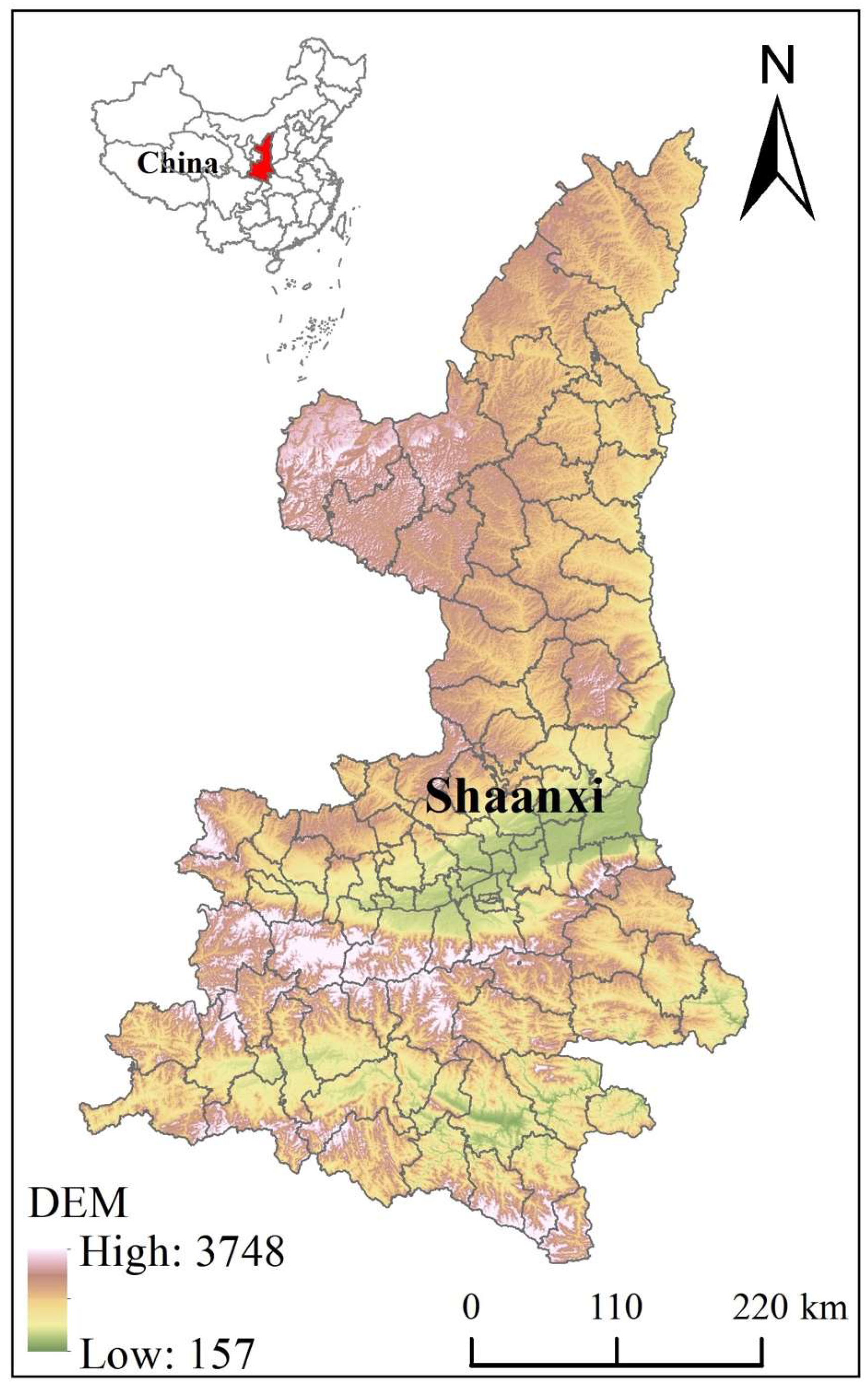
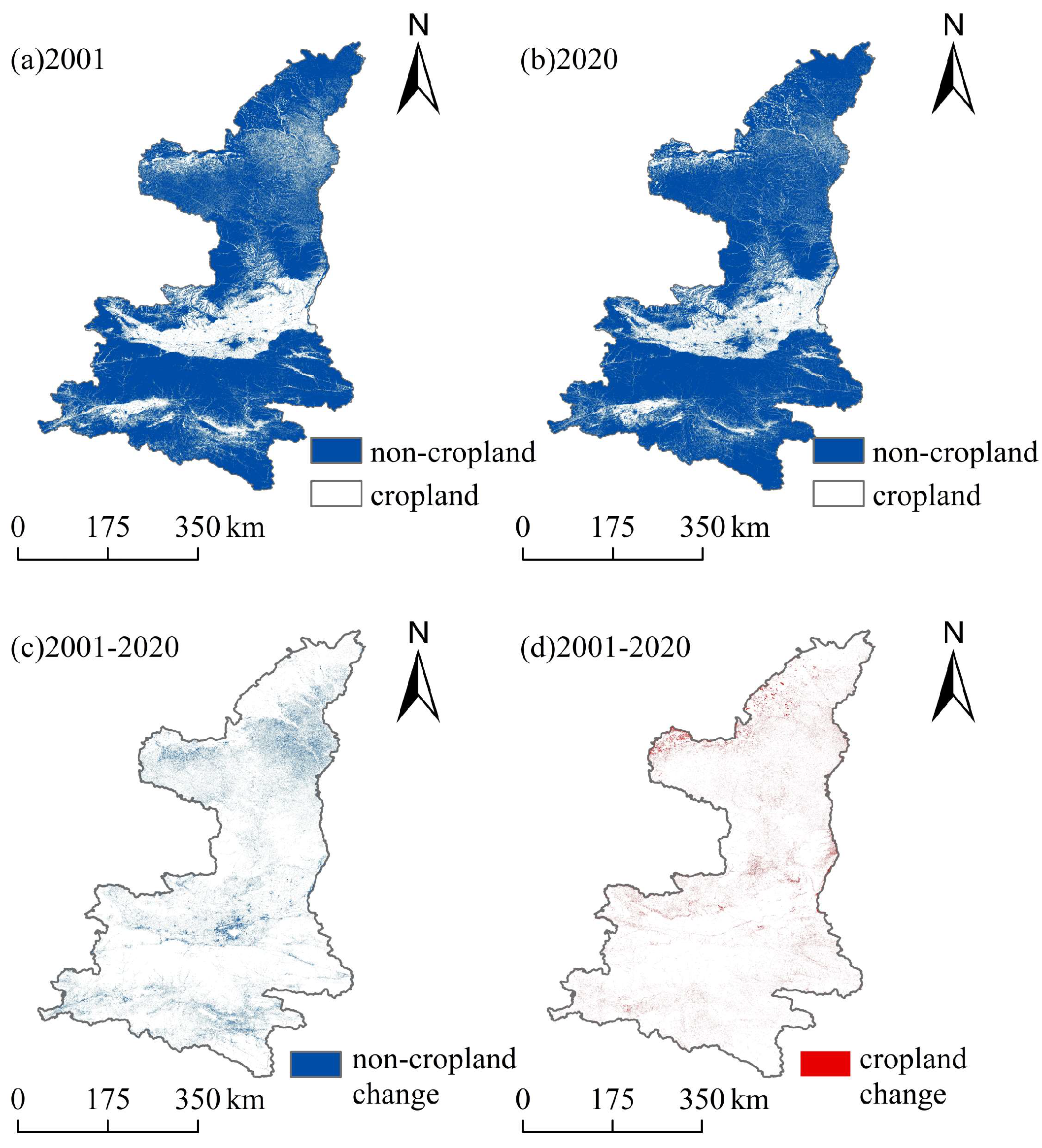
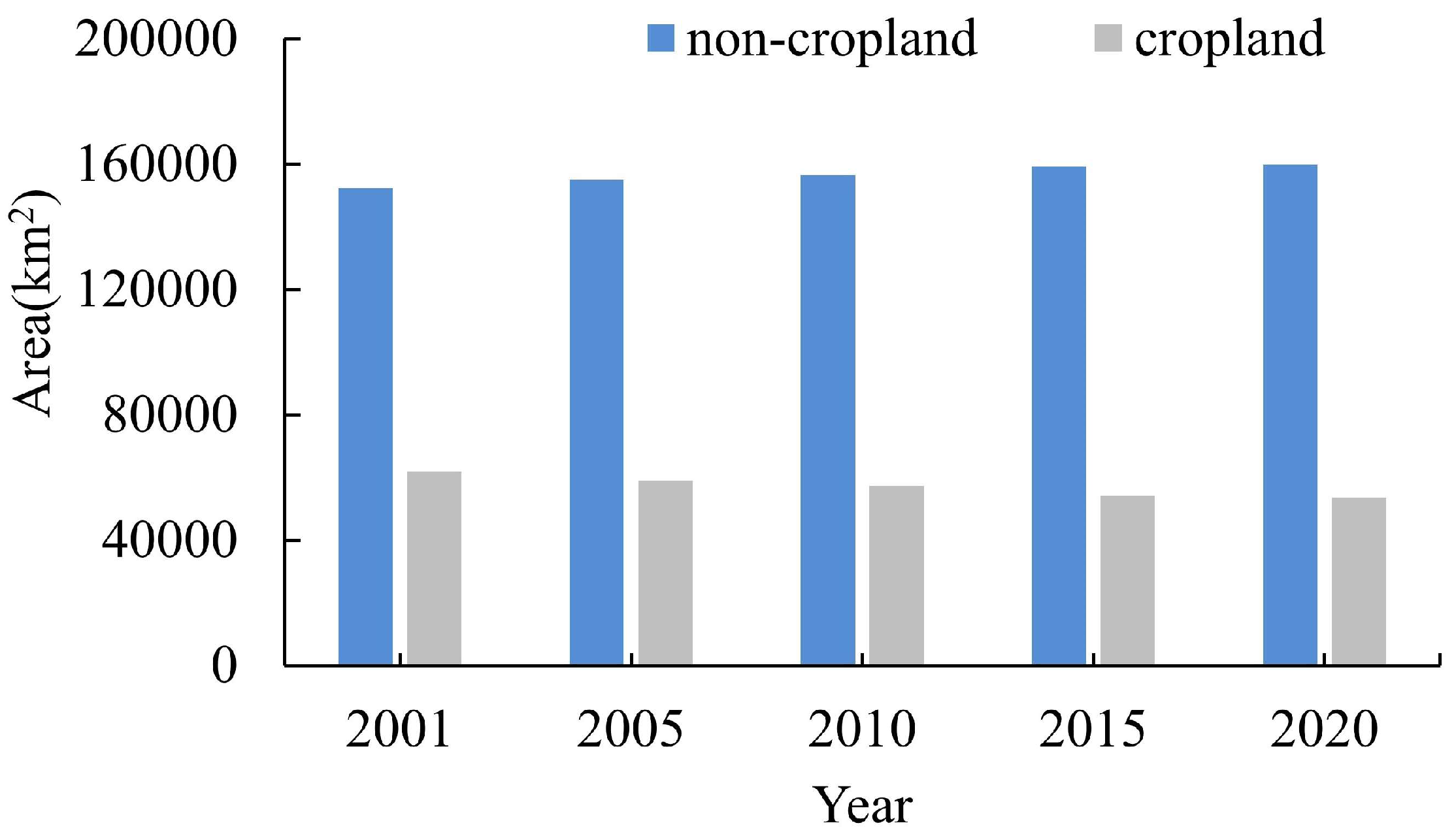
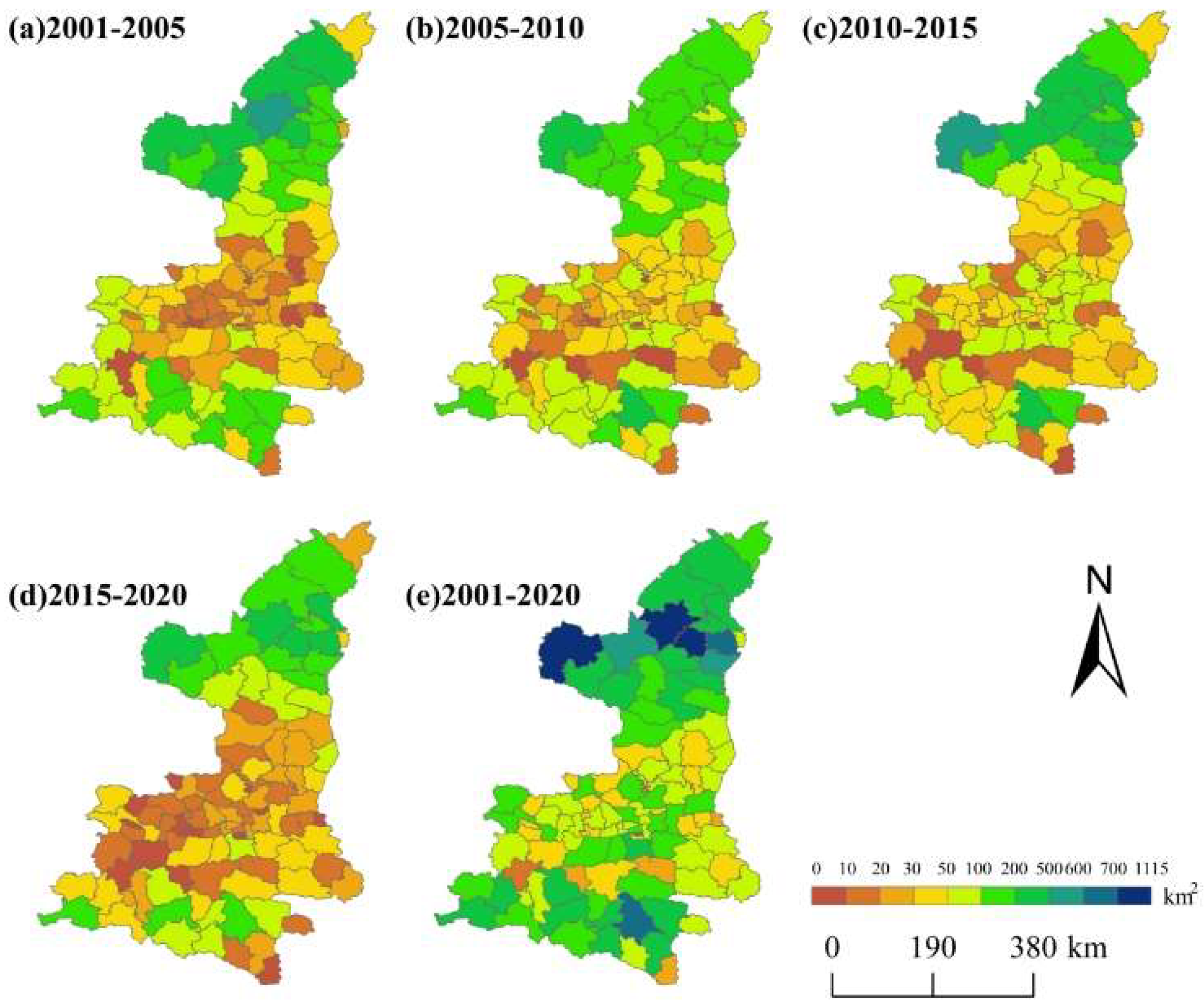

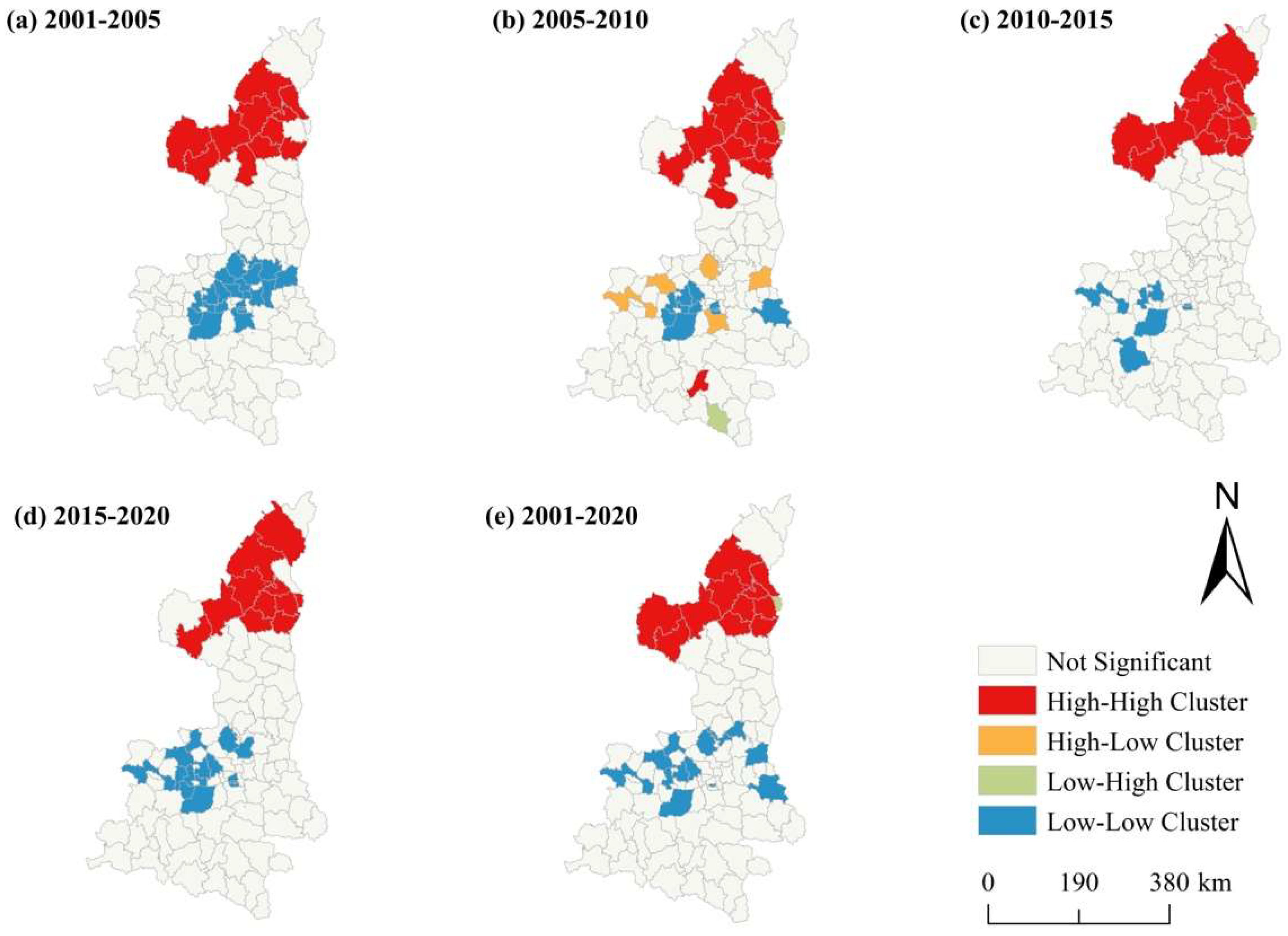
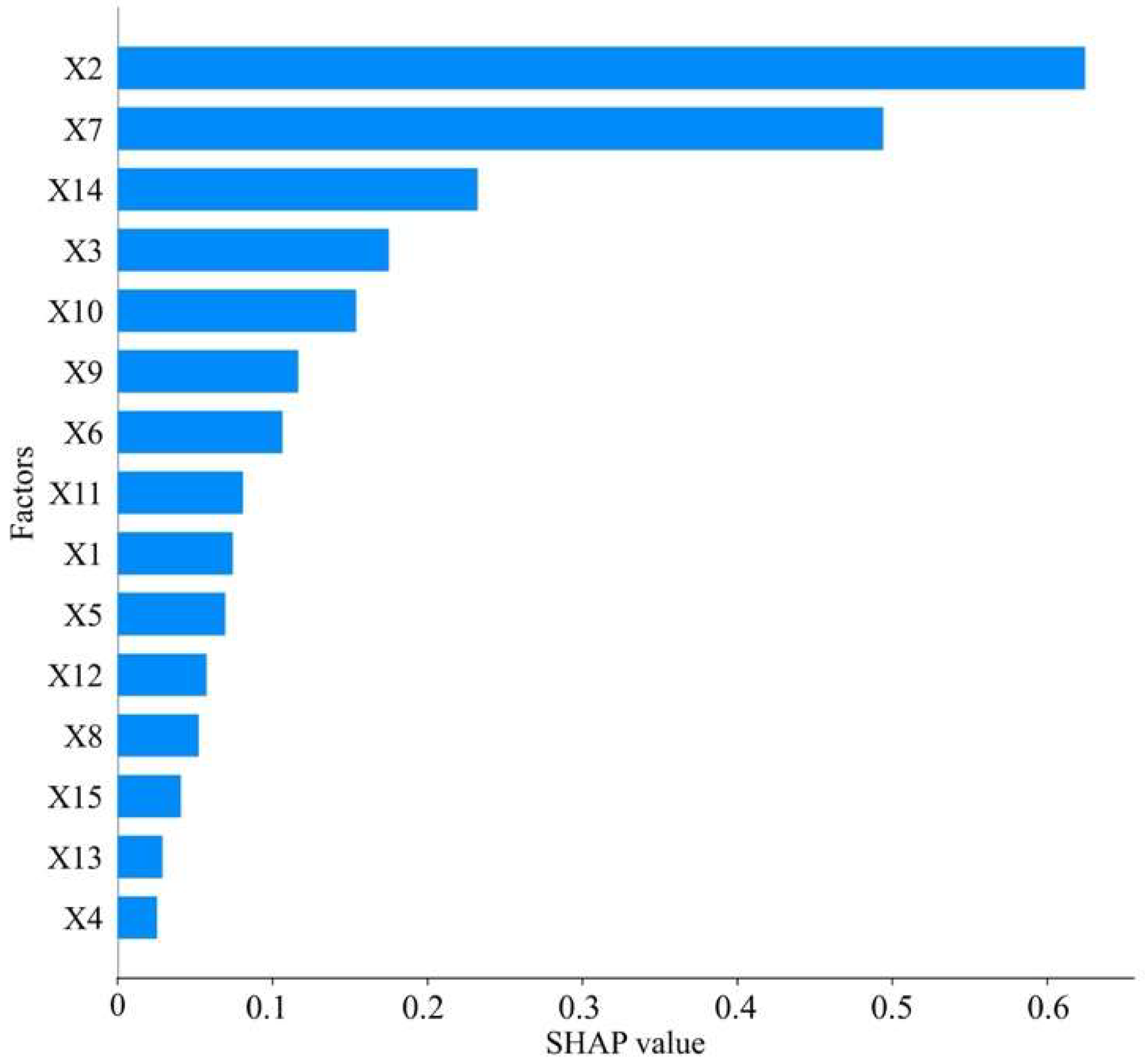
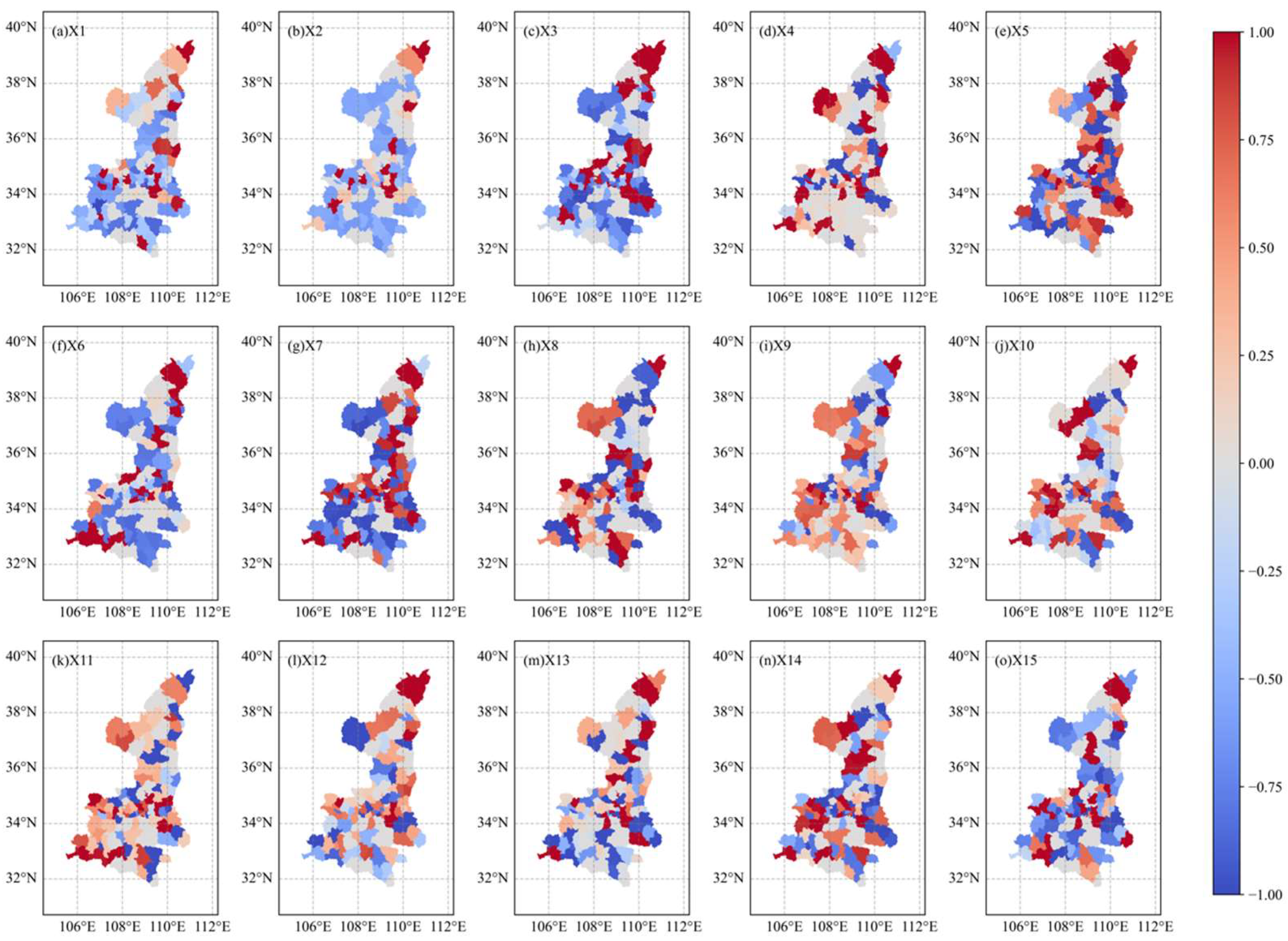

| Period | Z | p | Moran’s I |
|---|---|---|---|
| 2001–2005 | 9.92 | 0.00 | 0.58 |
| 2005–2010 | 7.14 | 0.00 | 0.43 |
| 2010–2015 | 8.85 | 0.00 | 0.52 |
| 2015–2020 | 8.01 | 0.00 | 0.43 |
| 2001–2020 | 8.96 | 0.00 | 0.54 |
| Train_R2 | Train_RMSE | Train_MAE | Test_R2 | Test_RMSE | Test_MAE | |
|---|---|---|---|---|---|---|
| RF | 0.79 | 0.08 | 0.05 | 0.59 | 0.20 | 0.12 |
| XGboost | 0.84 | 0.09 | 0.05 | 0.65 | 0.07 | 0.09 |
| LightBGM | 0.81 | 0.10 | 0.06 | 0.59 | 0.11 | 0.08 |
| OLS | 0.26 | 0.18 | 0.13 |
Disclaimer/Publisher’s Note: The statements, opinions and data contained in all publications are solely those of the individual author(s) and contributor(s) and not of MDPI and/or the editor(s). MDPI and/or the editor(s) disclaim responsibility for any injury to people or property resulting from any ideas, methods, instructions or products referred to in the content. |
© 2025 by the authors. Licensee MDPI, Basel, Switzerland. This article is an open access article distributed under the terms and conditions of the Creative Commons Attribution (CC BY) license (https://creativecommons.org/licenses/by/4.0/).
Share and Cite
Yan, H.; Chen, H.; Wang, F.; Qiu, L. Dynamics of Cropland Non-Agriculturalization in Shaanxi Province of China and Its Attribution Using a Machine Learning Approach. Land 2025, 14, 190. https://doi.org/10.3390/land14010190
Yan H, Chen H, Wang F, Qiu L. Dynamics of Cropland Non-Agriculturalization in Shaanxi Province of China and Its Attribution Using a Machine Learning Approach. Land. 2025; 14(1):190. https://doi.org/10.3390/land14010190
Chicago/Turabian StyleYan, Huiting, Hao Chen, Fei Wang, and Linjing Qiu. 2025. "Dynamics of Cropland Non-Agriculturalization in Shaanxi Province of China and Its Attribution Using a Machine Learning Approach" Land 14, no. 1: 190. https://doi.org/10.3390/land14010190
APA StyleYan, H., Chen, H., Wang, F., & Qiu, L. (2025). Dynamics of Cropland Non-Agriculturalization in Shaanxi Province of China and Its Attribution Using a Machine Learning Approach. Land, 14(1), 190. https://doi.org/10.3390/land14010190









